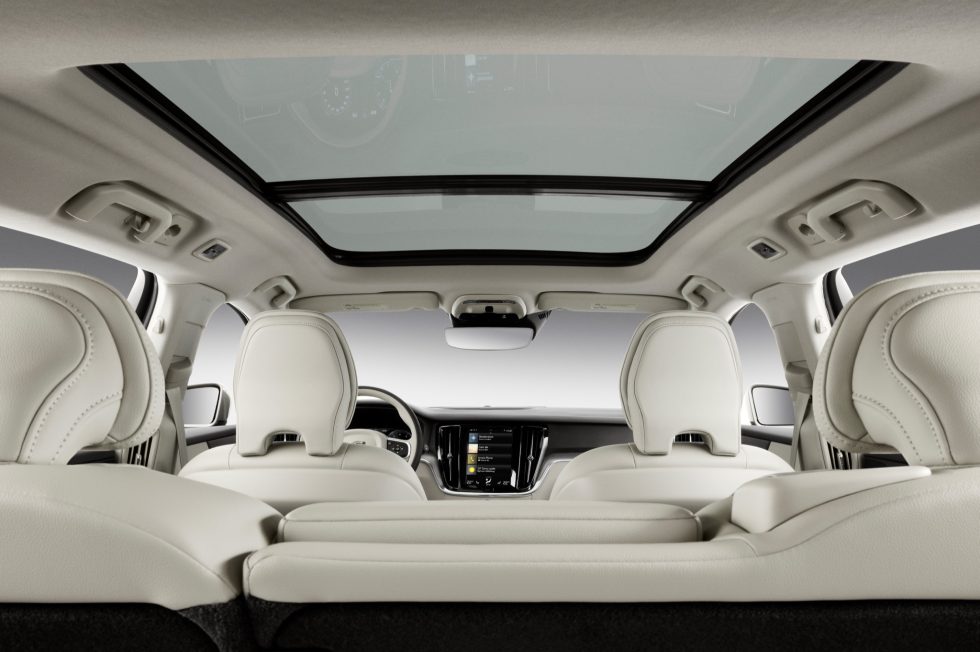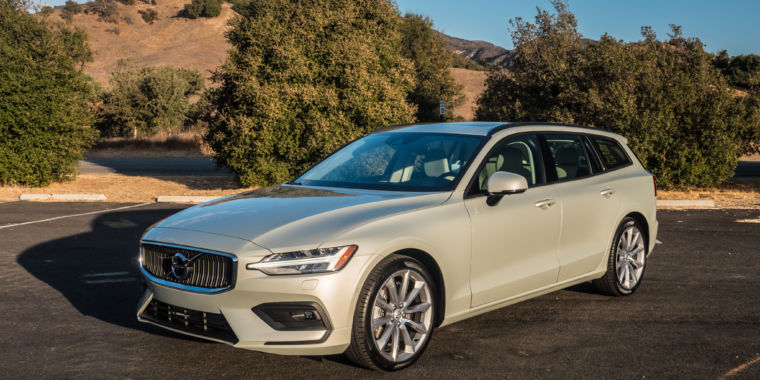

Forget the impending death of the sedan, as an automotive species the station wagon should be on life support. Which is a shame, because station wagons are great. The utility of an SUV without the high seating position, sure, but also without the high center of gravity and drag coefficient. In return, a much more elegantly proportioned vehicle, one that would be more popular but for the decades-old stigma of being a “mom car.” (The same fate is coming for you, SUV.) Almost no one sells a wagon any more, which makes some people cross enough to leave angry comments online about the stupidity of car companies. In their defense, the car companies tell me angry Internet comments aren’t really worth the same as an actual deposit, and they have too few of those to make it worthwhile. Not Volvo though.
The Swedish automaker has been fascinating to watch these past few years as it has bloomed thanks to Geely’s investment. Little happened for the first few years, but Volvo used the investment to thoroughly modernize the way it designed and built cars. Platforms have given way to modular architectures that simplify production yet at the same time allow for a great flexibility when it comes to designing different vehicles.
In 2015, the
XC90 SUV marked the introduction of the first of these new architectures, called Scalable Product Architecture. SPA lets Volvo build large and midsized vehicles, and it was soon joined by an
S90 sedan and
V90 wagon. Three years later and the SPA line-up is complete. Last year
the XC60 arrived, a more moderate take on the 21st century Swedish SUV.
Yesterday we wrote about the new S60 sedan which means we’ve saved the best one for last. The new V60 wagon.
-
The new Volvo V60 looks better than any SUV, drives better than any SUV, and is almost as practical as any SUV. The station wagon is too good to die. Jonathan Gitlin
-
Would the world be a happier place if more of us drove wagons? Jonathan Gitlin
-
The V60’s interior will be familiar to anyone who’s been in another SPA Volvo. The Momentum trim cars get this cool seat fabric. Jonathan Gitlin
-
There are worse interiors you could choose for sitting in early morning traffic. Jonathan Gitlin
-
The back seat has plenty of room. Jonathan Gitlin
-
A more sombre interior is possible if you go for the R-Design trim. Volvo
-
A T8 plug-in hybrid will be available at launch. -
Like the other SPA cars, the V60 uses a mix of varying strength steels in its chassis. Volvo
-
It’s a Volvo, so it’s going to be very safe. Volvo
-
I actually met this handsome chap the day before I drove the V60, on the S60 part of the event. But I forgot to include it in that article, and he’s too adorable to leave on the cutting room floor. Jonathan Gitlin
-
A Lancia Delta S4. Both it and the V60 T6 (and T8) have all-wheel drive and an engine with a supercharger and a turbocharger. Other than that they are almost totally unalike. National Motor Museum/Heritage Images/Getty Images
SPA means the V60 has access to the same combination of powertrains as the other 60-series vehicles. T5s are front-wheel drive, T6s are all-wheel drive, and T8s are AWD plug-in hybrids. And they have the same (different) versions of Volvo’s modular 2.0L direct injection four-cylinder gasoline engines: a turbocharger with 250hp for the T5, a turbocharger and a supercharger and 316hp for the T6, or that plus a 10.4kWh battery pack and an electric motor that gives you a combined 400hp.
That is correct, by the way; the engines have both supercharger and turbocharger. Volvo says this eager-beaver approach to forced induction means its small inline-four can go up against the bigger six- and even eight-cylinder engines most everyone else uses. While there are doubtless more super-turbocharged (or is it turbo-supercharged) engines out there, the only other one that springs to mind is the one that Lancia built for its Group B Delta S4.
For those of you not already appreciating the supreme irony at work here, a brief explanation.
Group B was a famously dangerous time in motorsport. Introduced in 1982, it was a new set of technical rules for both rallying and circuit racing. It lived alongside Group A, which still exists today, and Group N which sort-of exists, but neither of those are infamous. That’s because they took the idea of “production-based” quite seriously. You had to build thousands of the now-modified racing cars to qualify Group A (part of a process called homologation), for example.
On the other hand, Group B was a much more permissive take. While its technical rulebook paid lip service to road legality, it gave carmakers an unusually free hand. The result were cars with way too much power in the absence of tires, brakes, or cockpit protection to make any of it safe. And the Lancia Delta S4 is the scariest Group B car of all, the one that got the whole thing banned.
This is not a Group B car
The Volvo V60 is quite unlike a Delta S4. Instead of a flimsy metal space-frame chassis there’s extensive use of boron steel in the chassis. The lightest V60 is the T5, which coincidentally makes 3hp more than the 200 road-going S4s. But it weighs 3,748lbs (1,700kg) and not 2,646lbs (1,200kg). Factor in another 255lbs (116kg) for the T6’s AWD system, or an as-yet undetermined amount more for the T8 plug-in hybrid bits and take note: this is not a featherweight.
That’s not to say it feels a heavy car to drive. Volvo has kept the control weights low, and there’s little slack or hesitation in the steering. We were only able to drive a V60 T6, which felt more than at home in the early morning traffic from Santa Monica up to the canyons of Malibu and back. But even the four hundred horsepower T8 will feel like it’s moving in geologic time compared to the fire-spitting rally car.
The Lancia is mid-engined, with a firewall behind the driver and passenger that deprives it of any real utility; even the 200 road cars were strictly two-seaters with no real cargo space. The V60 puts its engine up front, and takes advantage of a much longer wheelbase (V60: 113.1″2,873/mm, Delta S4: 96″/2,440mm) to give the rear seat occupants some meaningful leg room. With the rear seats occupied, there’s 23.2 cubic feet (657L) of cargo room in the back; fold them flat and that becomes 50.9 cubic feet (1,441L).

Between the panoramic roof (standard on all V60s) and the light color palette of the Momentum trim interior, the V60’s interior practically encourages family road trips. Because it’s lower to the ground than an SUV, it’s easier to load bulky stuff—surfboards, bicycles, canoes, grandfather clocks—into the back or onto the roof.
The Volvo has an entire glossary worth of advanced driver assists and passive safety technology, most of which didn’t even exist when the S4 was being built. Pilot Assist, Volvo’s implementation of adaptive cruise control and lane keeping, recently got dinged by Consumer Reports compared to three similar systems from Cadillac, Tesla, and Nissan. In my opinion it’s not that it’s a bad system—there are many worse ones out there Consumer Reports could have tested. But the UI could definitely do a better job of avoiding mode confusion, and the lane keeping aspect often has different ideas than I do about the optimal line around any given corner.
I have no such qualms about the infotainment system. The nine-inch IR touch screen is almost as responsive as a capacitive design, but far more tolerant of gloved fingers. And the tile-based UI remains a favorite among the Ars office. As for the Lancia, the closest the it got to cutting-edge infotainment may well have been one of those fancy TAG Heuer rally clocks.
If all of this has made you think you need a Delta S4 in your life, then bravo, for that is a brave and bold decision. If you’re leaning towards the V60—as good a case for one car to do it all as any—then you too will need patience, for the wagon won’t go on sale until later in 2019. Volvo’s also waiting until closer to the time before announcing pricing, but the competitive pricing and equipment lists for the S60 and XC60 should give some clues as to MSRP. Soon we shall know if Volvo’s bet on the wagon makes sense.








